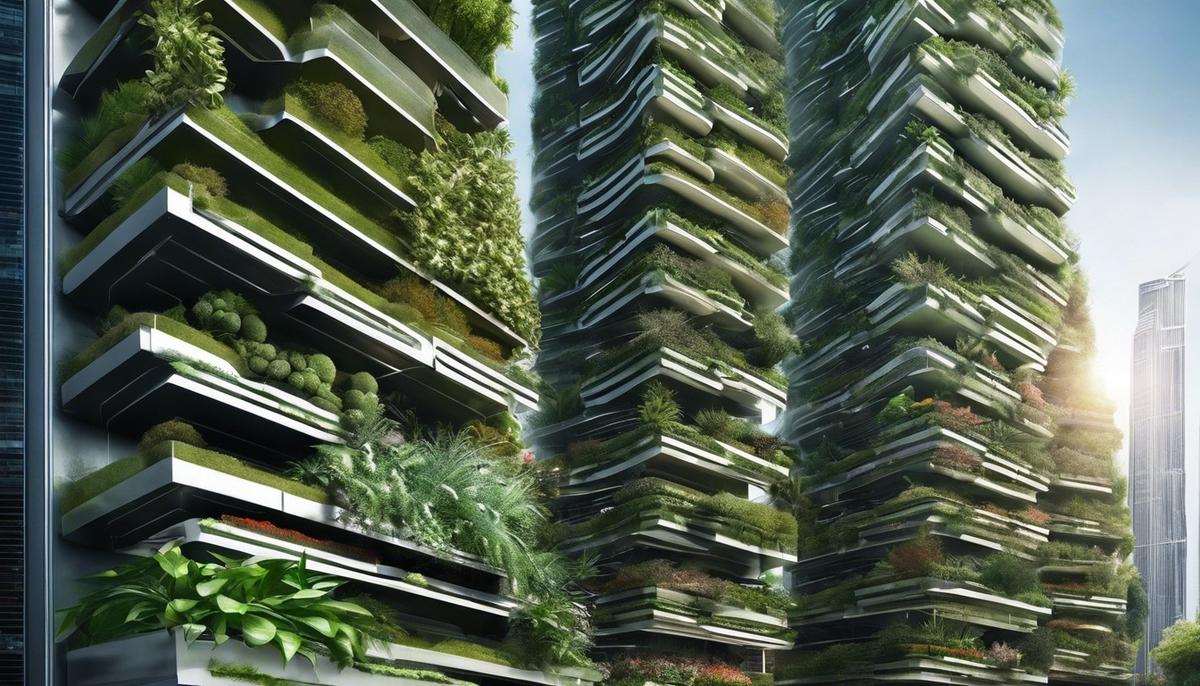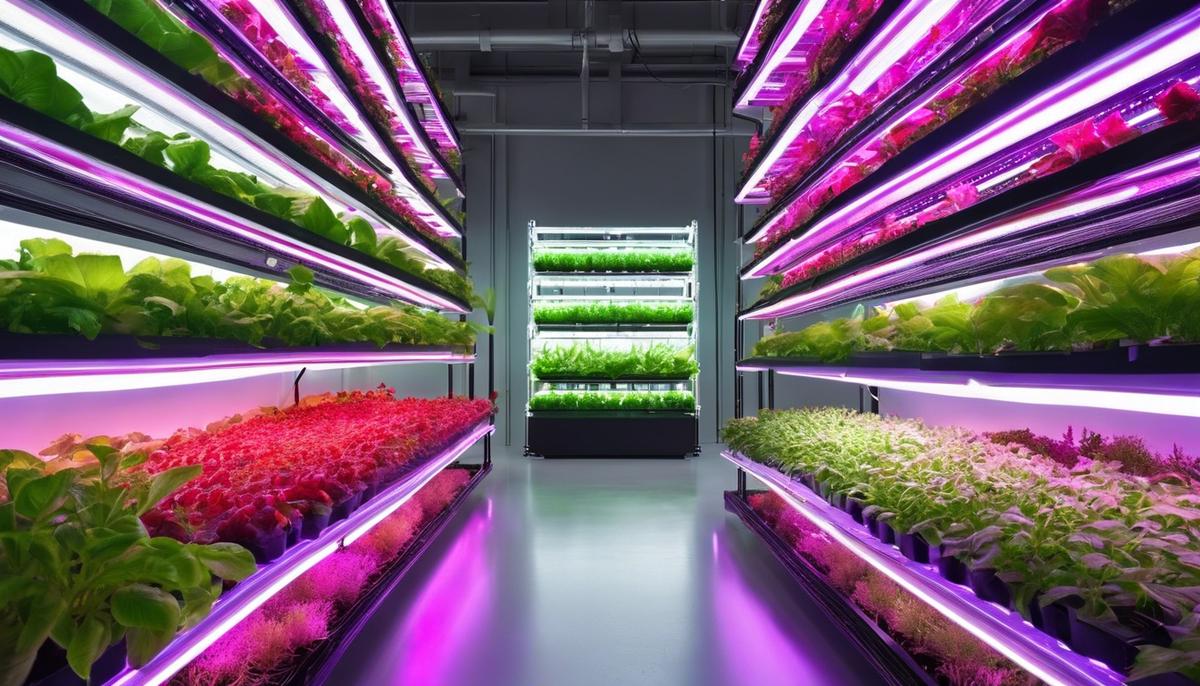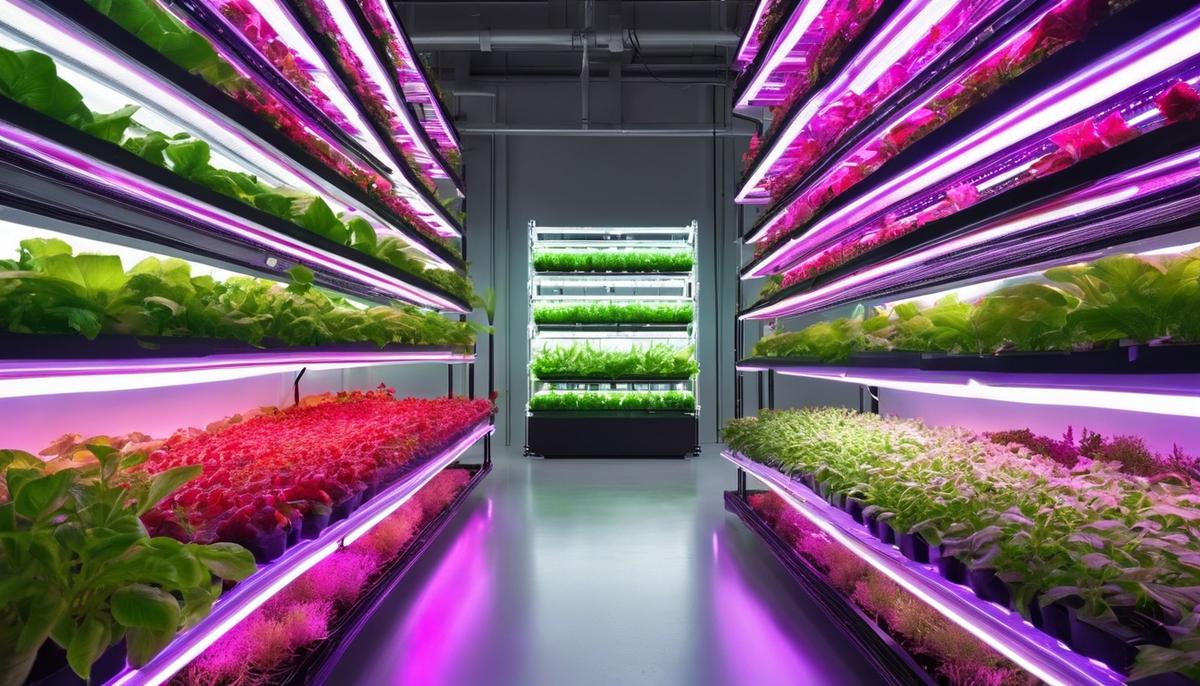.jpeg)
Vertical Farming Technology
Description: Emerging at the junction of technological innovation and agricultural revolution, vertical farming technology marks a monumental stride for mankind's quest for sustainability and efficiency in farming. The growing global concern for the environment and food security has birthed this transformative technology, which manifests in varying forms from hydroponic to aeroponic and aquaponic systems. Accompanied by a symphony of intricate orchestrations like artificial lighting control, precise nutrient delivery, and accurate climate modulation, vertical farming is far more than just a change in direction. With a focus on the essentials of vertical farming technology, the profound influence of the light spectrum, the technical challenges and solutions, and the potential impacts on food security and the environment, this examination of vertical farming will illuminate its significance as a viable solution for a sustainable future. Delving into the world of vertical farming unveils an intricate dance between science and technology, each adhering to the principles that govern crop cultivation and environmental sustainability. The very concept of this agricultural practice stemmed from the need to cater for the burgeoning global population and the ever-dwindling farmland space. Vertical farming offers an innovative solution, a distillation of several scientific concepts and cutting-edge technologies intended to optimize plant growth in skyscraping structures. This endeavor is not just about stacking plants upward but requires effectively harnessing light, temperature, hydration, and nutrients to promote an environment conducive for plant growth. At the heart of vertical farming is hydroponics, the practice of growing plants without soil. By utilizing a nutrient solution comprised primarily of water and essential minerals, plants are provided with the necessary components for growth directly to their roots. This principle demonstrates an intimate understanding of plant biology, exploiting the fact that plants do not require soil per se but rather the nutrients contained within. Complementing hydroponics is another keystone technology in vertical farming: LED lighting. Through advancements in photonics, LED lights are customized to emit the precise spectrum of light required for photosynthesis. This provides the necessary light energy for growth, regardless of external weather conditions, and allows manipulation of plant growth rate and nutritional composition. Furthermore, it leads to significant energy savings, a testament to vertical farming's sustainability goals. Another technology shaping the face of vertical farming is aeroponics, a method where plant roots are kept in air and are misted with the essential nutrients rather than immersed in a solution. This concept, used by NASA for space farming, heightens plant growth efficiency due to the greater oxygen exposure awarded to the roots. Integrating these technologies with precision agriculture is imperative. This relies on advanced algorithms and data analytics, subsequently guiding decisions relating to watering, lighting, and nutrient provision. The goal is to optimize resource use and increase yield, ensuring vertical farming operates with the high efficiency required to sustain its functional and environmental promise. Finally, the role of cloud computing and Internet of Things (IoT) technologies cannot be overstated. They bring about real-time monitoring and control of the farm environment, ensuring optimal conditions for plant growth. This level of automation leads not only to labor-saving but also to an increased degree of accuracy, producing crops of consistent quality and predictable yields. In conclusion, vertical farming stands as the epitome of human ingenuity, encapsulating meticulous use of technologies to exploit principles of plant biology and environmental science. It calls for an appreciation of this intertwining complexity, as it transforms urban landscapes into agricultural hubs, thereby illuminating a promising path towards a sustainable future. Vertical farming, a cutting-edge agrarian methodology aimed at combating prevailing food security issues, supplements the traditional cultivation model with a systematic, tech-driven approach. A paramount aspect of this revolutionary technique involves manipulating the light spectrum: a low-profile area in conventional agriculture but a linchpin in vertical farming. Analyzing this aspect requires a fundamental understanding of photosynthesis and plant biology. Photosynthesis, the process by which plants generate energy, relies on specific light wavelengths to fuel the plant's metabolic processes. The light spectrum visible to the human eye—ranging from 400nm (violet) to 700nm (red)—is aptly known as Photosynthetically Active Radiation (PAR). Different wavelengths within PAR invoke distinct responses in plant tissues: blue (450-495nm) light serves plant morphology and chlorophyll production, while red (620-750nm) light influences flowering and fruiting. In the context of vertical farming, this illumination-centric plant metabolism allows spectrum manipulation to enhance growth optimization. LEDs, now a preferred light source due to their energy efficiency and durability, are pivotally used to manage the photosynthetic spectrum. These engineered light sources, capable of emitting specific wavelength combinations, can be tailored to match the requirements of each crop type, maturity stage, and desired outcome—ranging from biomass accumulation to nutritional concentration. By altering the light spectrum, vertical farmers control 'photomorphogenesis,' plant responses including stem elongation, leaf expansion, and chloroplast movement. For instance, by adjusting the blue and red LEDs' light ratio, farmers can stimulate or limit plant growth; consequently, orchestrating the ideal symbiosis of size and nutritional content. Furthermore, manipulating ultraviolet (UV) and far-red light—lying at the light spectrum's extreme ends—offers another fascinating dimension. While traditionally overlooked due to their negligible role in photosynthesis, modern research is learning to harness these wavelengths as part of overall spectrum manipulation. Minuscule UV light portions induce stress physiology in plants, leading to increased nutrient concentration—a beneficial factor for crops like lettuce, kale, or basil. Contrarily, far-red light (700-750nm) influences 'shade avoidance responses', such as increased stem length and leaf size, pivotal for certain crops. GPS-guided spectroradiometers and spectral imaging cameras offer advanced tools for monitoring light spectrum variations, supplemented by data analytics' predictive potential. This information assists in refining the light manipulative techniques, enabling an ever-evolving, self-sustaining environment wherein each crop receives the tailored spectrum it needs. The science of light spectrum manipulation in vertical farming presents an alluring mix of biology, photonics, and information technology. As research continues to decode the complex language of light that plants understand, vertical farms will get closer to their goal: optimal yield and quality with minimum input, emerging as the panacea for burgeoning urban food demands and environmental constraints. By comprehending and harnessing the power of photons in plant life cycles, humanity steps ever closer towards its larger goals—sustainability, food security, and preservation of biodiversity. In this photonic dance of life, as humans work hand-in-hand with the laws of nature, vertical farming is not just a demonstrating human adaptability—it is a testament to our collective resilience and ingenuity. Indeed, the path forward in vertical farming is fraught with substantial technological hurdles, each requiring a nuanced understanding of incredibly complex processes at play. Yet, through research, innovation, and sheer tenacity, significant advancements have been made to hurdle over these challenges. One such challenge is energy efficiency. While LED lights create the ideal spectrum for photosynthesis, significant energy input is required to maintain this artificial ecosystem, far more than traditional greenhouses. However, advancements in energy-efficient lighting and alternative energy sources have the potential to minimize this obstacle. Researchers are exploring different spectral combinations of light, potentially reducing energy costs. For instance, some plant varieties require less blue light, and therefore an LED array that emits a reduced amount of blue light could lower energy consumption without sacrificing productivity. Additionally, in vertical farming, achieving optimal humidity levels is distinctly challenging due to the highly controlled environment and the high water requirement for plant cultivation. However, experts have proposed efficient solutions to this problem. Employing advanced technologies like nanometer-sized water droplets can maintain humidity and reduce water usage dramatically. Condensation recovery techniques can also reduce water waste, making the vertical farms more resource-efficient. Another tricky beast to tackle lies in the realm of plant diseases. In a vertical farm, the close planting regime can lead to the rapid spread of diseases. However, constructing plant health monitoring systems with sophisticated software and sensors can detect the early symptoms of plant diseases, paving the way for timely elimination and prevention of further spread. Support structures for the plants also pose a challenge, as space in vertical farming is multi-dimensional. Standard in-ground and greenhouse crops have the luxury of growing on a single plane. Yet, vertical farms stack these planes upon one another and hence require the precise engineering of vertical support structures. The approach of utilizing light-weight, strong, and recyclable materials, such as advanced composites and bio-plastics, is yielding noteworthy outcomes. Lightweight rack structures also allow easy reconfiguration, adding flexibility to crop management. Despite the technical hurdles in vertical farming, they are not insurmountable. With continued research and technological advancement, the industry will continue to adapt and overcome these challenges, pushing the boundaries of what is feasible in urban agriculture. At its heart, vertical farming embodies the perfect collision of agronomic principles with the tenets of advanced technology, proving to the world that innovation, indeed, is the lifeblood of progress. The edifice of human knowledge is always under construction, and vertical farming is an eloquent testimony to this fact. Vertical farming, an explicit marriage of agriculture and technology, offers substantial promise for the enhancement of food security and environmental sustainability. The potential contribution to food security comes from the simple fact that vertical farming increases the density of food production, a trait significantly attractive in context of increasing urbanization and burgeoning city populations. It results in the potential yield per unit area being dramatically more compared to traditional farming techniques. However, there are aspects that go beyond simply producing more food. For instance, vertical farming could represent a new level of local food production. Traditional farming provides food grown hundreds, if not thousands, of miles away from its point of consumption. In contrast, vertical farming often occurs within or very close to the city, reducing the journey required from the farm to the consumer's table. This localized food production could decrease food waste significantly, further improving overall food security. With regard to environmental sustainability, vertical farming's year-round nature ensures the elimination of seasonal restrictions usually constraining traditional agriculture, further expanding its sustainable potential. Besides, vertical farming is innately resistant to many natural disasters, which under normal circumstances could devastate acres of farmland, thereby ensuring a steadier and more reliable food supply. Moreover, vertical farming significantly reduces water consumption, a consequence of the innovative irrigation strategies it employs; both hydroponic and aeroponic methods consume less water than traditional soil-based farming. The latter, for example, uses up to 95% less water, an incomparable advantage in water-stressed urban environments. The locus of vertical farming within the built environment also creates opportunities for symbiosis with existing structures and systems. For instance, aligning the farm with a renewable energy source would lead to a significant reduction in greenhouse gas emissions typically associated with food production, making it even more environmentally sustainable. Additionally, vertical farming may contribute to biodiversity by lessening the impact of traditional farming on natural habitats. As these farming systems become more efficient and prevalent in cities, there could be less need for extensive mono-crop farming, which often involves deforestation. Critical to the success of vertical farming is the ability to select suitable crops for this kind of cultivation. Crops that thrive in stacked layers will be preferable, along with those that can flourish under artificial lights. Thus, extensive botanic research is required to discover and develop plant varieties that are fit for these novel farming environments. Vertical farming is not without its challenges paradoxically mirrored in the energy requirements for vital operations like providing artificial light and maintaining controlled environments, thus raising questions about overall energy efficiency. Nevertheless, continuous strides in technology are mitigating those concerns. For example, innovative plant growth lighting technologies are proven to conserve energy while maximizing growth. In conclusion, vertical farming provides a multifaceted approach to tackling food security and promoting environmental sustainability. The intersection of traditional agronomic principles and avant-garde technology proves that the future of farming can indeed reach new heights. This innovative blend of agriculture and technology is continuously evolving, constantly pushing the boundaries of what's possible in the quest for sustainable food production. And although the journey upwards is fraught with challenges, the potential rewards can help ensure a nutritious and sustainable future for all. The advent of vertical farming holds enormous potential in addressing pressing global issues such as food insecurity, environmental degradation, and climate change. As the world reckons with these impending challenges, vertical farming delivers a promising solution, fostering a sustainable and efficient way of food production. The technology certainly comes with its share of challenges, from high initial costs to energy consumption issues and the threat of crop diseases. However, with the endless potential it holds and the innovative solutions already in play to counter these hurdles, vertical farming emerges as a significant game-changer in global agriculture. As we assess its impact on food security and environmental health, it is clear that vertical farming represents a profound paradigm shift towards a more sustainable and secure future.Vertical Farming Technology
Fundamentals of Vertical Farming Technology
Understanding Vertical Farming: Fundamental Principles and Crucial Technologies

The Role of Light Spectrum in Vertical Farming
The Art and Science of Spectrum Manipulation in Vertical Farming


Technical Challenges and Solutions in Vertical Farming

The Impact of Vertical Farming on Food Security and Environment
